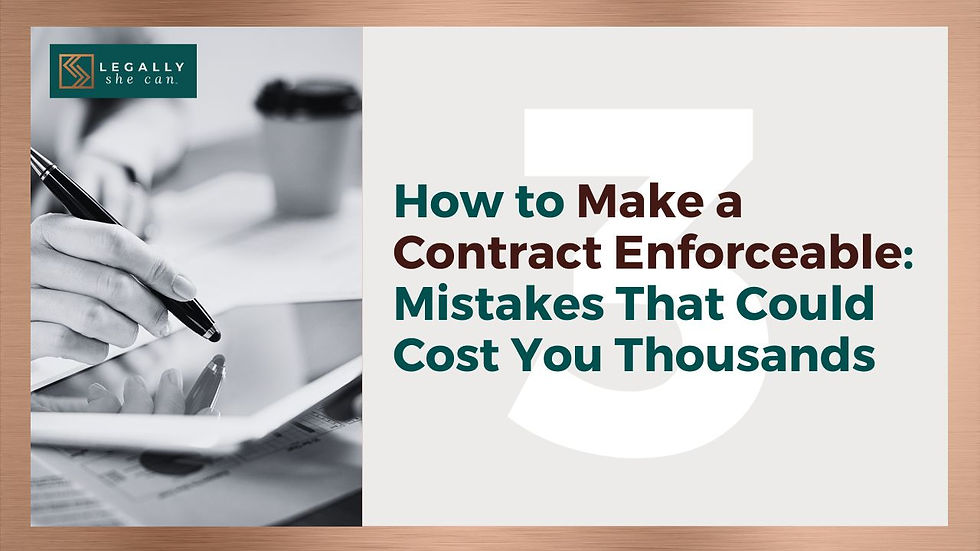How to Make a Contract Enforceable: 3 Mistakes That Could Cost You Thousands
- Vena Verga-Danemar
- Mar 6
- 4 min read
Updated: Jul 20
Have you ever had a client ghost you after you delivered your work? No response, no payment, and no way to contact them?
If this has ever happened to you, you’re not alone. Many coaches, consultants, and experts assume that just having a contract template is enough to protect their business.
But here’s the truth: A contract that isn’t properly structured may not be enforceable—which means you could be left with no legal recourse if a client refuses to pay.
And that’s exactly what happened to my friend.
But before the story this article will cover the following:
The Costly Mistake of Unenforceable Contracts
How to Make a Contract Enforceable and 3 Critical Mistakes to Avoid
Protect Your Business Before It’s Too Late
Frequently Asked Questions (FAQs)

I am your guide
Who am I anyway, and why you should read on:
I’m Vena Verga-Danemar, a licensed lawyer turned legal and business strategist for online business owners. I’ve helped dozens of women build their coaching practices by simplifying legal requirements—so you can avoid overwhelm, confusion, and legal drama.
She Had a Contract… But It Wasn’t Enforceable
The frantic call came in:
"Vena, she stopped taking my calls! I sent an invoice, but it came back—address unknown! I have a contract, but… what do I do?"
She had a signed contract, yet her client vanished without paying.
Here’s the hard lesson: A contract is only as strong as its weakest link. If key legal elements are missing, enforcing the contract—and getting paid—can become a nightmare.
So, how do you make sure your contract actually protects you and ensures you get paid?
How to Make a Contract Enforceable: 3 Critical Mistakes to Avoid
Before sending a contract to a client, make sure you’re not making one of these three costly mistakes:
1. Failing to Verify the Client’s Legal Name & Address
The #1 mistake that makes contracts difficult to enforce is failing to identify the other party correctly.
If you’re working with a business, ensure the contract names the correct legal entity and is signed by an authorized person.
If it’s an individual, always verify their identity—asking for a government-issued ID isn’t unreasonable.
➡️ Why this matters: If a client disappears, incorrect details could make it impossible to track them down or take legal action.
2. Sending the Contract After Payment (Instead of Before)
Your contract must be reviewed and signed before any payment is made.
If you send a contract after the client has paid, they can argue that they never agreed to your terms.
This can make it harder to enforce payment obligations, refund policies, or other critical terms.
✅ Solution: Always send your contract before any transaction occurs and ensure the client agrees to the terms in writing.
➡️ Why this matters: If a client later disputes their payment obligations, you’ll have a legally binding contract in place to support your case.
3. Not Using a Legally Binding E-Signature Tool
Simply emailing a contract and asking for a scanned signature might not hold up in legal disputes.
Can you prove who signed the contract and when?
Can you prove they agreed to your terms?
So what it is the best practice: Use a legally compliant e-signature tool like PandaDocs, which:
✔ Verifies identities
✔ Records timestamps
✔ Meets international Data Protection Laws
➡️ Why this matters: If your client ever disputes the contract, an audit trail will prove it was signed legally, making it easier to enforce.
Protect Your Business Before It’s Too Late
My friend skipped Step 1 and Step 3—and now, she’s chasing a ghost client.
💡 Don’t wait until you have a legal problem to fix your contracts.
That’s why I created Legally Fluent Essential Bundles—to help coaches, consultants, and experts avoid legal blind spots and ensure their contracts are enforceable.
✅ Inside the bundle, you get:
✔ Legally Binding Contracts – Ready-to-use, expert-drafted agreements
✔ Explainer Videos – Know exactly what each clause means
✔ Compliance & Updates – Stay protected with the latest legal changes
🚀 Make sure your contracts actually work for you.
Frequently Asked Questions (FAQs)
🔹 How do I make a contract enforceable?
To make a contract enforceable, ensure you (1) verify client details, (2) send the contract before payment, and (3) collect legally binding e-signatures with software like PandaDocs.
🔹 What happens if a contract isn’t enforceable?
If a contract is missing key legal elements, you may not be able to force the other party to comply with the terms—which could mean unpaid invoices, legal disputes, and lost revenue.
🔹 What’s the best way to ensure a client pays me?
Verify the client’s legal details (name, address, ID).
Use a contract with clear payment terms.
Get a legally binding e-signature before starting work.
➡️ Want contracts that actually protect you?
FREE RESOURCES TO HELP YOU SUCCEED
Step 1: Start with the Free Business Checklist
Get your step-by-step guide to building a strong foundation for your coaching or consulting business.

Step 2: Watch the Free Training
Learn the five blind spots that can sabotage your success -- How to fix them, legally protect your business and gain peace of mind.
Vena Verga-Danemar is a lawyer turned legal and business strategist, conflict navigator and founder of Legally She Can — a legal education and business platform that helps coaches, consultants, and online entrepreneurs protect their work, resolve business conflicts, and build trust-based, AI-resilient businesses.
She is the creator of the Trust Alchemy™ Method, combining real legal experience with business ownership insight. Based in Switzerland and serving clients globally, Vena writes at www.legallyshecan.com about legal strategy, business clarity, brand protection, and visibility — helping expert-based businesses grow with confidence and credibility.





![Coaching Contract Template Guide Written by A Lawyer: Protect Your Coaching Practice [Updated in 2025]](https://static.wixstatic.com/media/4ca2c7_a685f227723c4691b8e70e0b195fa3b5~mv2.jpg/v1/fill/w_980,h_551,al_c,q_85,usm_0.66_1.00_0.01,enc_avif,quality_auto/4ca2c7_a685f227723c4691b8e70e0b195fa3b5~mv2.jpg)








Comments